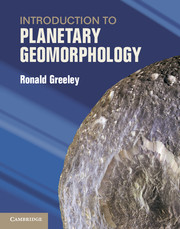Book contents
- Frontmatter
- Contents
- Foreword
- Preface
- Acknowledgments
- Chapter 1 Introduction
- Chapter 2 Planetary geomorphology methods
- Chapter 3 Planetary morphologic processes
- Chapter 4 Earth’s Moon
- Chapter 5 Mercury
- Chapter 6 Venus
- Chapter 7 Mars
- Chapter 8 The Jupiter system
- Chapter 9 The Saturn system
- Chapter 10 The Uranus and Neptune systems
- Chapter 11 Planetary geoscience future
- Appendices
- References
- Further Reading
- Index
Chapter 2 - Planetary geomorphology methods
Published online by Cambridge University Press: 05 February 2013
- Frontmatter
- Contents
- Foreword
- Preface
- Acknowledgments
- Chapter 1 Introduction
- Chapter 2 Planetary geomorphology methods
- Chapter 3 Planetary morphologic processes
- Chapter 4 Earth’s Moon
- Chapter 5 Mercury
- Chapter 6 Venus
- Chapter 7 Mars
- Chapter 8 The Jupiter system
- Chapter 9 The Saturn system
- Chapter 10 The Uranus and Neptune systems
- Chapter 11 Planetary geoscience future
- Appendices
- References
- Further Reading
- Index
Summary
Introduction
For many years, the study of the geomorphology of the Earth was primarily descriptive. In the middle of the twentieth century, the emphasis shifted to a more process-oriented approach, with the goal of understanding the reasons behind a landform’s appearance. The analysis of planetary surfaces has gone through a similar history. When the first close-up images of the Moon and planets were obtained, their surfaces were described, and some attempts were made to interpret their origin and evolution. Unfortunately, some of these attempts were rather immature. Planetary scientists with a geology background drew on their experiences with Earth, taking a simplified “analog” approach; i.e., if it looks like a volcanic crater, it must be of volcanic origin. Scaling the sizes of features and considerations of planetary environments took a back seat to the simple “look alike” answer.
As the Apollo program drew to a close in the early 1970s and the exploration of the full Solar System emerged, planetary geomorphology became more process-oriented, with attempts to take differences in planetary environments into account, while maintaining fundamental geologic principles.
In this chapter, the following question will be addressed: how can one study the geology of a planet or satellite without actually going there? This will include the approaches used in planetary geomorphology and the types of data that are commonly available for the study of planetary surfaces.
Information
- Type
- Chapter
- Information
- Introduction to Planetary Geomorphology , pp. 15 - 33Publisher: Cambridge University PressPrint publication year: 2013
